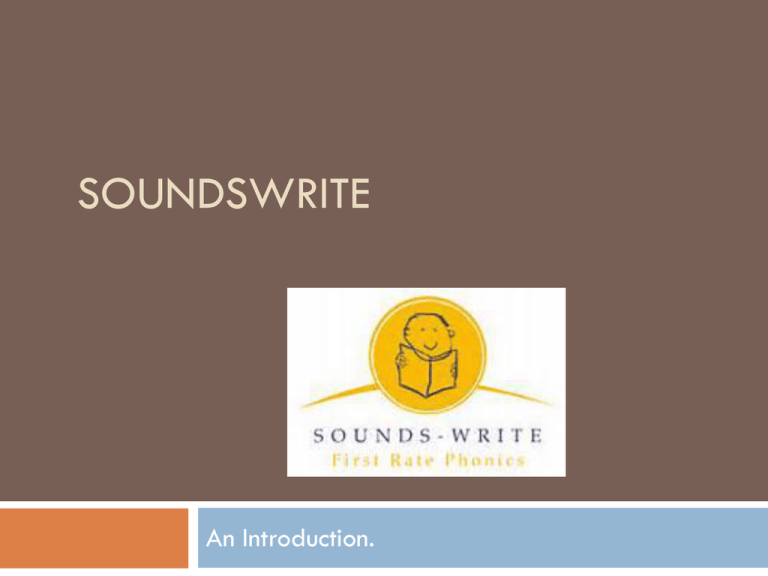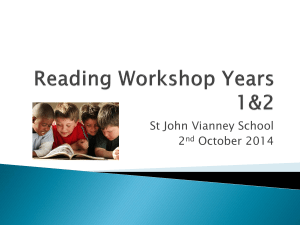SoundsWrite - Castle Lower School
advertisement

SOUNDSWRITE An Introduction. Structure of Sounds-Write • The programme consists of three parts: – – – • • The Initial Code The Extended Code Polysyllabic words Teaching begins in Reception, through to Year 2 Children are grouped according to ability and sessions occur daily until the end of Year 2. Children are assessed regularly so the teacher is able to ensure they are in the correct group for their level. The Initial Code • • • • • The Initial Code concentrates mainly on individual letter sounds, but does move onto some initial blends The lessons are in a script form so the language used by the adult is consistent and accurate The phonemes (sound) are presented in the context of a whole word not in isolation We always refer to the phoneme not the letter name Precise pronunciation of the sound is important – a pure sound is vital SoundsWrite Over the following weeks we will be introducing these sounds in the following order: Unit 1: a, i, m, s, t /a/ as in 'cat', /i/ as in 'pin', /m/ as in 'map', /s/ as in 'sip' and /t/ as in 'ten' Unit 2: n, o, p /n/ as in ‘not’, /o/ as in ‘pop’, and /p/ as in ‘pen’ Unit 3: b, c, g, h /b/ as in ‘big’, /c/ as in ‘cup’, /g/ as in ‘get’, and /h/ as in ‘hen’ SoundsWrite Unit 4: d, f, v, e /d/ as in ‘dog’, /f/ as in ‘fun’, /v/ as in ‘vet’, and /e/ as in ‘leg’ Unit 5: k, l, r, u /k/ as in ‘kit’, /l/ as in ‘leg’, /r/ as in ‘run’, and /u/ as in ‘bun’ Unit 6: j, w, z /j/ as in 'jug', /w/ as in 'wig', and /z/ as in 'zip' SoundsWrite Unit 7: x, y, ff, ll, ss The letter X /ks/ as in 'fox'; /y/ as in 'yes'. The double consonants <ff>, <ll> and <ss>, represent the sounds /f/, as in 'sniff', /l/ as in 'fill', and /s/ as in 'miss'. Lesson One t s a _________ _________ _________ SoundsWrite When you are reading a reading book with your child, do all the things you would normally do; talking about the story, discussing the characters, predicting what is going to happen next, and so on. But, whenever you come to a two- or three-sound word, which has in it the sounds your child has already come across, ask them to have a go by saying the sounds and listening for the word. SoundsWrite After your child has tackled three-sound words, their teacher will be moving on to words with four and five sounds and, again, you can best support you child by giving them as much practice as you can. SoundsWrite Extended Code... This is the point in which the alphabet code becomes more complex. The program separates at this point, moving onto what has been termed the Extended Code. By this stage children are now able to: Blend Segment Manipulate phonemes and graphemes. SoundsWrite Before moving onto the extended code children should know that: Phonemes in speech are represented by letters; A phoneme can be represented by one letter; Some phonemes can be represented by two letters ( <sh>, <ch>, <th>, <ll>, <ss>, etc.) SoundsWrite There are two types of lessons in the extended code, the majority focus on the phonemes (sounds); A target phoneme is chosen and all lessons are taught with the words containing that phoneme. The main objective is to teach the phoneme and the various graphemes that can represent it; in other words, the various ways the sound can be spelled. For example: the phoneme ‘ae’ can be spelled <a>, <ai>, <ea>, <a-e>, <eigh>, etc SoundsWrite The phonemes and graphemes are presented in the order which allows pupils to read the greatest number of words as early as possible. Lesson 6 ay l p _________ _________ _________ SoundsWrite Every week or so, we will begin a new unit and build the new sounds into what we have already introduced. SoundsWrite We will always be talking about sounds not letters, and you can help most effectively by not using letter names, only sounds. We want children to learn that letters are symbols for sounds, so that when they see the letters <m> <a> <t>, they say and hear /m/ /a/ /t/. SoundsWrite To begin with we will be working only with 2 and 3 sound words. Your child needs to say the sounds and listen to hear what the word is. For this reason, sounds need to be said very precisely. For example, when we see the letter <m>, we say /m/ and not ‘muh’. SoundsWrite When your child has said all the sounds in a word and then read the word, ask them to write the word.








